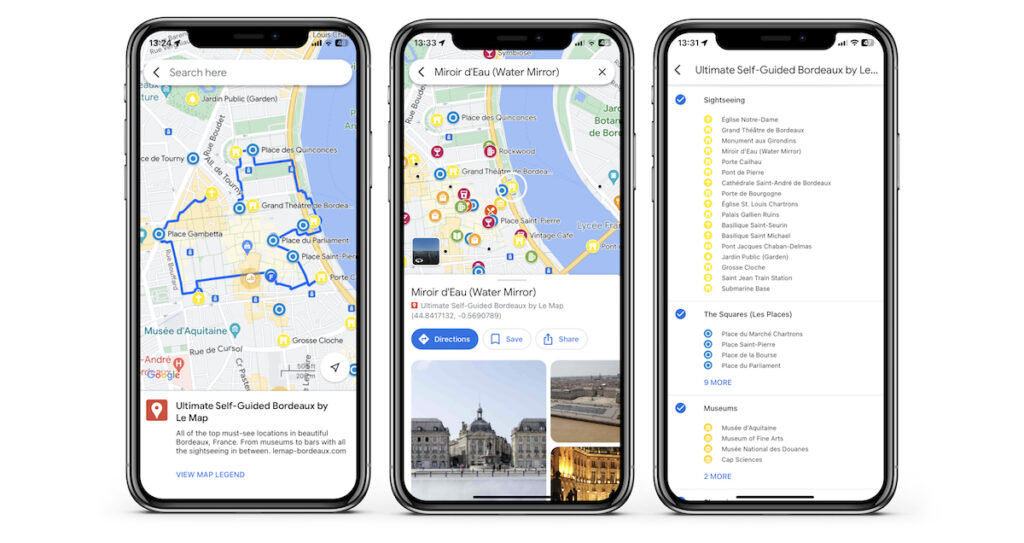Immerse yourself in Bordeaux’s unique wine heritage while you’re here, of course, although it would be a missed opportunity not to see the many sights and monuments that make the city itself so special. As such, here is a walking tour in 15 steps that takes you across the city centre and slightly outside into the Chartrons district.
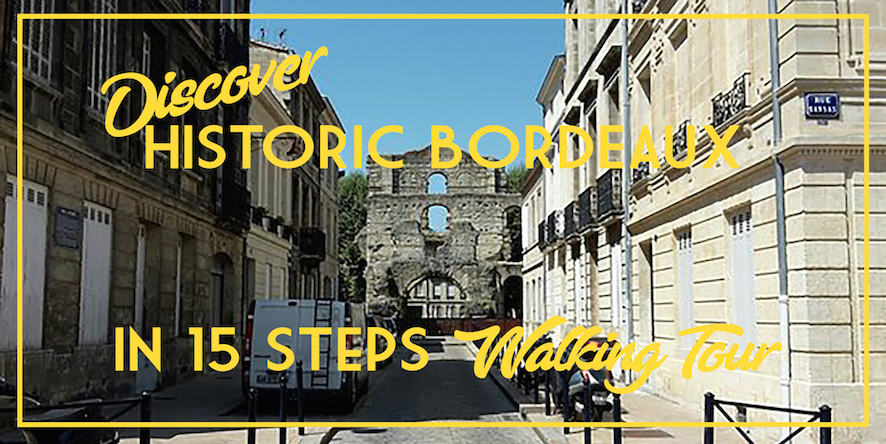
15 Steps to take you around Bordeaux’s most picturesque sights, on foot or on bike.
For decades, Bordeaux has been a tourist destination for wine lovers, but more and more the world is waking up to what Bordeaux has to offer as a city.
Once you’ve caught a glimpse of the quays, or some of the incredible architecture that spans a millenium (in one case nearly two!), it’s not hard to understand why Bordeaux is a UNESCO World Heritage Site.
You should immerse yourself in Bordeaux’s unique wine heritage while you’re here, of course, although it would be a missed opportunity not to see the many sights and monuments that make the city itself so special. As such, here is a walking tour in 15 steps that takes you across the city centre and slightly outside into the Chartrons district.
Without further ado, let’s begin! Grab LE MAP BORDEAUX and let’s get going!
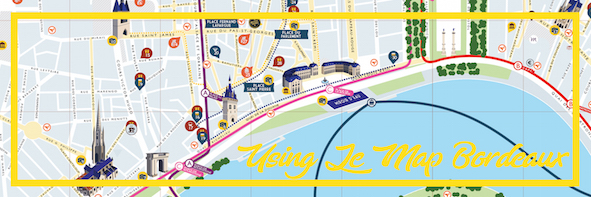
STEP 1: PLACE DE LA VICTOIRE
Our first stop throws us directly into the 18th century modernisation of the city. The neo-classical arch that stands in the middle of the square (la porte d’Aquitaine) was built to replace the medieval defensive structure. The buildings that line the square date from this period or, as is the case for the university building, the 1800s. The obelisk placed in 2005 conforms with the neo-classical style. Look closely at the two bronze turtle statues munching on grapes and you’ll see that they bear the names of Bordeaux’s various wine appellations.
Hungry? – Fresh Burritos
Thirsty? – HMS Victory, La Grange, L’Excale
STEP 2: ST. MICHEL QUARTER
On the main square, your eyes are immediately drawn to the imposing bell tower. Both the church and the independent spire were built in the mid-15th century. The square we see now was previously a cemetery. From here to the indoor market 2 minutes walk away (Marché des Capucins), stalls fill the square almost every morning of the week. Since springing up outside the city walls, the area has always been a melting pot of cultures.
Hungry or thirsty? – Excuse My French Café
STEP 3: LA GROSSE CLOCHE
“The big bell”. This gorgeous bell tower was built towards the end of the English rule over Aquitaine (1154-1453). The lion-shaped weathervane- a symbol of the Kings of England- stands proudly on top of this defensive structure from the Middle Ages as testament to this fact. At the time, it was the town hall’s belfry and formed part of the defensive walls. It even had a small jail!
Hungry? – Santosha, Breakfast Club
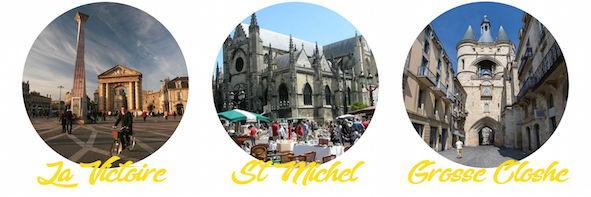 STEP 4: PLACE DU PALAIS
STEP 4: PLACE DU PALAIS
The imposing Porte Cailhau dominates this square. Much like la Grosse Cloche, Porte Cailhau was a gatehouse that formed part of the defensive walls; you can see where the building was attached. You can see similarities in the style of both, as Cailhau was built shortly after, once the region had become French once more. The defensive structure protected le Palais de l’Ombrière , a palace that stood on this square for 12 centuries!
Thirsty? – Le CanCan
Hungry and thirsty? – Au Bon Jaja, Sweeney Todd’s, Frog & Rosbif
STEP 5: PLACE ST. PIERRE
There is evidence of a sanctuary dedicated to Saint Peter on this site from the 6th century, however the current structure dates from the 14th, 15th and 16th centuries (which is still pretty old!). The square developed respectfully around the church during the city’s 18th century modernisation.
Hungry? – La Maison du Glacier, Phood
STEP 6: PLACE DU PARLEMENT
In the centre of Bordeaux, this beautiful ornate square stands as a fine example of Bordeaux’s transformation in the mid-18th century. The square is elegant without falling into ostentatiousness. Here, we can see mascarons- stone heads that you can find all over the city- on all of the buildings. The most striking example of these strange sculpted heads is the fountain in the centre of the square.
Hungry? – Le Bar du Boucher
Thirsty? – Houses of Parliament
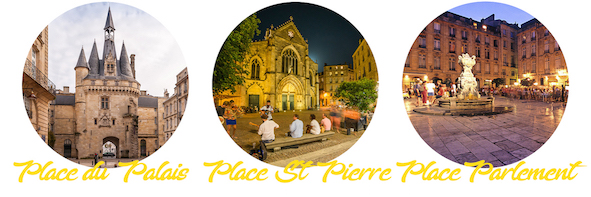 STEP 7: PLACE ST. PROJET
STEP 7: PLACE ST. PROJET
To get to this square, you have to take Rue Sainte-Catherine, supposedly the longest shopping street in Europe. At one end you can see the iconic Porte d’Aquitaine (Place de la Victoire), at the other you can see the resplendent Place de la Comédie. A church once stood on this square, the bell tower of which is still visible in the corner (above the sushi shop and next to the pizzeria). It has long since merged into the residential and commercial buildings on either side. The fountain was installed in 1715.
STEP 8: PLACE PEY-BERLAND
The Cathedral was where Eleanor of Aquitaine was married to Louis, King of France in 1137, 70 years after its inauguration. The bell tower followed at the end of the English reign, however for financial reasons it didn’t actually become a bell tower until 1851! The Archbishop of Bordeaux ordered the construction of the City Hall (l’Hôtel de Ville) to be his residence, however it swiftly took on a secular public role once the French Revolution arrived.
Hungry or thirsty? – Cheverus, Black List, Cock & Bull, Banana Café
STEP 9: PLACE GAMBETTA
This recently redeveloped “garden square” was one of the first built outside of the city walls. The guillotine was set up here before being moved to Place de la Victoire later on in the Revolution. There is a milestone at number 10 of the square that was placed in the late 19th century to mark the centre of Bordeaux. La porte Dijeaux is another one of these gateway arches that from the 18th century.
Thirsty? – Les Trois Pinardiers
Hungry? – La Toque Cuivrée
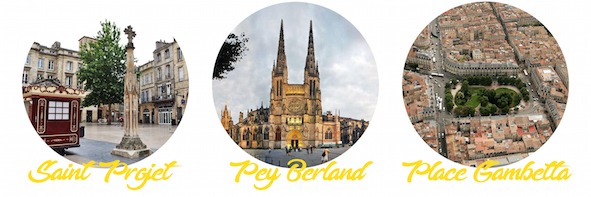 STEP 10: PALAIS GALLIEN
STEP 10: PALAIS GALLIEN
Most people will go home from Bordeaux without even knowing that this Roman amphitheatre exists. It’s such a travesty, as this is a rare example of the splendour of the Roman Empire in this corner of the world. What still survives of this structure is magnificent. The ruins give a strong impression of what the whole structure would have looked like. It’s worth the detour.
STEP 11: JARDIN PUBLIC
Arriving through the small arch at the Rue de la Ville de Mirmont, (once you’ve walked past the car park) your vision opens up onto a window back into the 18th century. The pavilion in the centre, the columns that line the bar, the idyllic impeccably kept gardens… it’s a beautiful space that now includes a children’s play area and botanical gardens.
STEP 12: BORDEAUX WINE MUSEUM & BORDEAUX MARITIME HISTORY MUSEUM
Learn about Bordeaux’s deep bond with the wine trade (and take a taste!) in this former wine broker’s mansion. It’s fascinating to see how the rise of these two industries coincided with Bordeaux’s rise in fortunes.
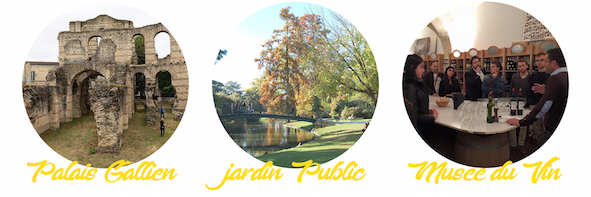
STEP 13: RUE NOTRE DAME
A quaint street in the heart of the Chartrons district. The whole area was home to workers from across Europe, working in the wine and shipbuilding trade. Once you walk along the quays you’ll see the CAPC Contemporary Art Museum. Nowadays, it occupies the Entrepôt Lainé behind the main entrance: a large warehouse built in the early 19th century to house colonial goods.
STEP 14: PLACE DE LA BOURSE & WATER MIRROR
This square is the symbol of Bordeaux’s prosperity during the triangular commerce of the 18th and 19th centuries, the time at which Bordeaux took on much of its current form. The water mirror was created in 2006 to better reflect (excuse the pun) the majesty of the square. All along the quays you can see remarkable 18th century facades that have become the trademark of UNESCO-era Bordeaux.
STEP 15: PLACE DE LA COMÉDIE
Finish off your tour with this remarkable square that wows you no matter what you direction you look in; it’s a real feast for the eyes! The Victor Louis-designed Grand Théâtre is a truly incredible example of 18th century architecture. The muses on top of the façade are a typical neo-classical influence, as are the famous columns. Step back along Allées de Tourny to get a sight of the impressive dome. The Grand Hôtel lies opposite, and it certainly is grand! Look towards Quinconces and you can see the spectacular Monument aux Girondins.
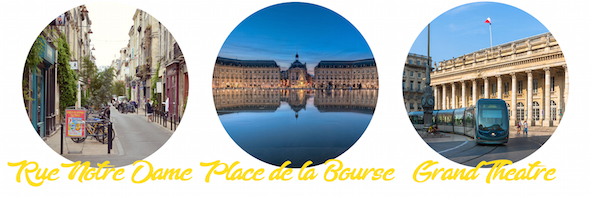
Now take a well deserved rest! Perhaps with a glass of wine…
Needless to say, taking a bike from the self-service system (VCub) or hiring one is a much faster way of getting around, but you can easily walk this tour. To complete the whole tour and fully enjoy the monuments, you’ll need to set aside approximately 5 hours if you’re on foot.
If you prefer to have an expert guide, you can take a Rustic Vines cycling tour (or a wine bar tour!), or you can even ride an electric Tuk-Tuk around the city!

